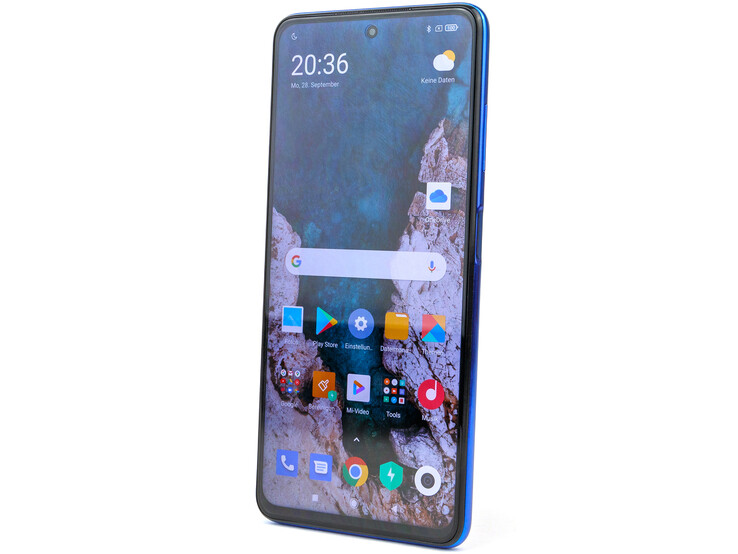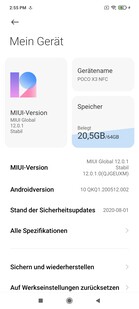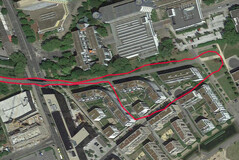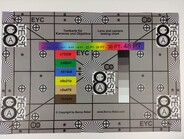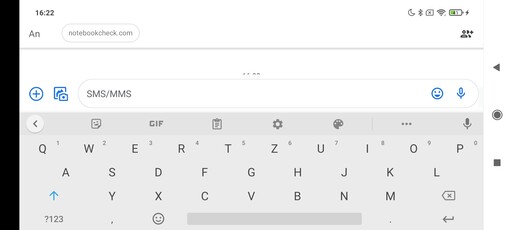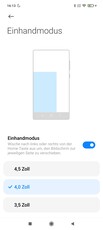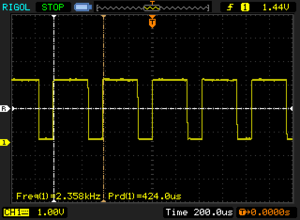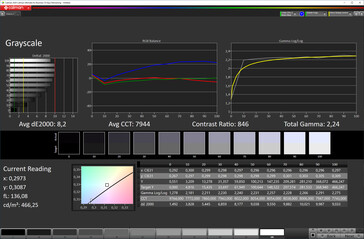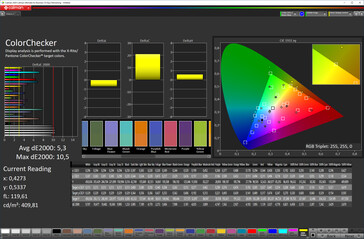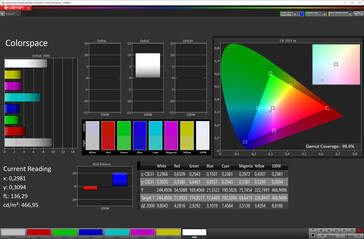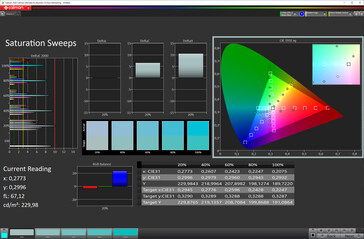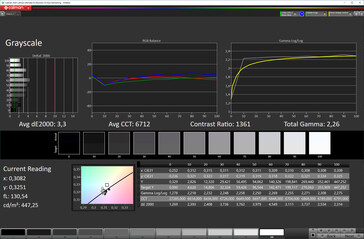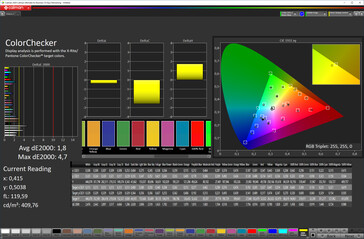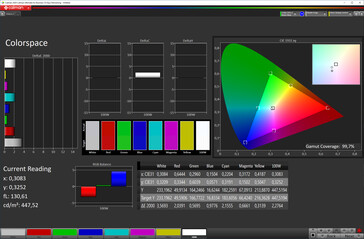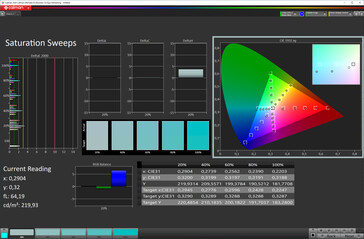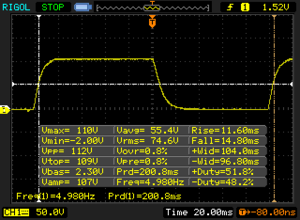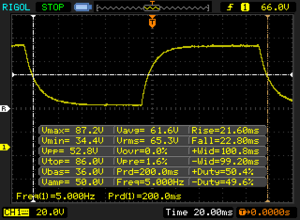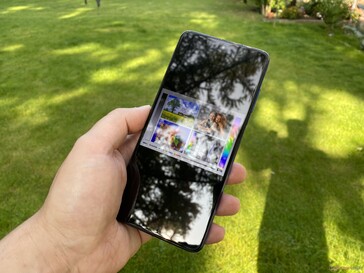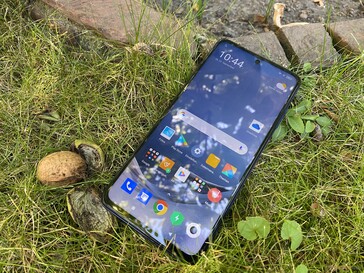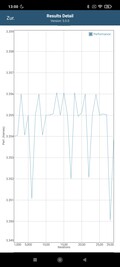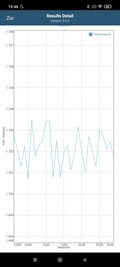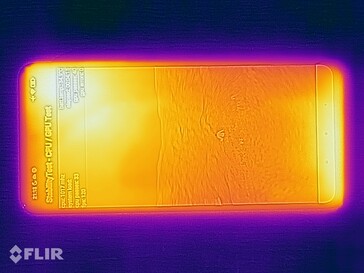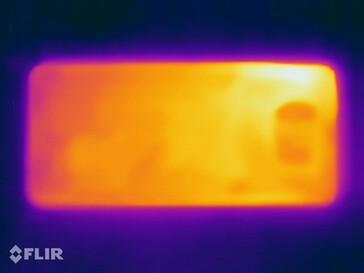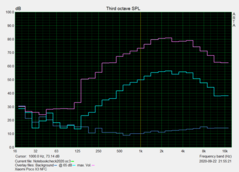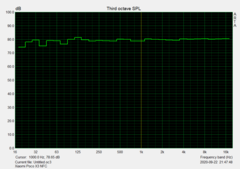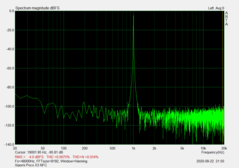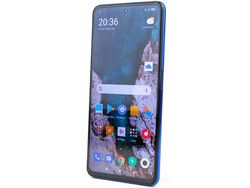Poco X3 NFC smartphone - Equipment champion in the mid-range
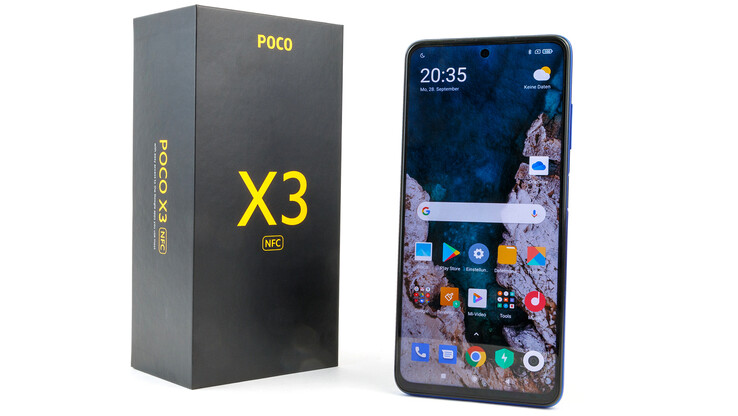
With the Poco X3 NFC, Xiaomi brings a smartphone to the market that can boast of powerful specs but still costs only 230 Euros (~$272) as its recommended retail price. At its introduction, it was even available for less than 200 Euros (~$236).
For that, buyers will receive a visually modern smartphone, which is also the first model coming with the brand new Snapdragon 732G. In addition, there is 6 GB of RAM and 64 GB of internal storage, which can even be expanded via microSD card. Those who need more storage can choose the 128 GB version for 40 Euros (~$47) more. For this price class, the camera equipment that centers around a 64 MP sensor is also astonishing. And the display also offers a refresh rate of 120 Hz.
The Poco X3 offers powerful equipment on the spec sheet. But is this also sufficient to stand up against the more expensive Pixel 4a or iPhone SE?
Comparison Devices
Rating | Date | Model | Weight | Drive | Size | Resolution | Price |
|---|---|---|---|---|---|---|---|
| 81.8 % v7 (old) | 10 / 2020 | Xiaomi Poco X3 NFC SD 732G, Adreno 618 | 215 g | 64 GB UFS 2.0 Flash | 6.67" | 2400x1080 | |
| 80.7 % v7 (old) | 05 / 2020 | Xiaomi Redmi Note 9S SD 720G, Adreno 618 | 209 g | 128 GB UFS 2.0 Flash | 6.67" | 2400x1080 | |
| 82.9 % v7 (old) | 08 / 2020 | Xiaomi Mi Note 10 Lite SD 730G, Adreno 618 | 204 g | 64 GB UFS 2.0 Flash | 6.47" | 2340x1080 | |
| 83.6 % v7 (old) | 09 / 2020 | Google Pixel 4a SD 730G, Adreno 618 | 143 g | 128 GB UFS 2.0 Flash | 5.80" | 2340x1080 | |
| 85.2 % v7 (old) | 05 / 2020 | Apple iPhone SE 2020 A13 Bionic, A13 Bionic GPU | 148 g | 128 GB NVMe | 4.70" | 1334x750 | |
| 81.3 % v7 (old) | 10 / 2020 | Samsung Galaxy M51 SD 730, Adreno 618 | 213 g | 128 GB UFS 2.0 Flash | 6.70" | 2400x1080 |
Case - A plastic-glass mix for the Poco X3
The Poco X3 NFC is available in blue and gray color. The painted aluminum frame gives a visually high-quality impression and the display is protected by Corning Gorilla Glass 5. Even though the back is made of plastic, it still looks high-quality. The prominent camera bump sticks out by an ample 2.4 millimeters (~0.1 in).
Considering the price class, the workmanship is very good. The clearances are tight and even. Only the card tray does not sit flush in the frame but is inserted a little deeper. The plastic frame around the display is not too wide, and a protective foil is applied on the glass in the state of delivery. The Poco smartphone responds to attempts of warping it with audible creaking noises, and the back can be pressed in slightly.
While the Xiaomi smartphone is protected against splashes according to the IP53 certification, it is not waterproof. The battery is built-in and cannot be replaced by the user.
Equipment - Filled to the brim
The USB-2.0 port of the Xiaomi phone has the Type-C connector and supports OTG, allowing you to connect external storage media or peripheral devices to the smartphone.
While storage cards with exFAT file system are supported, they cannot be formatted as internal storage. However, you can still move app data there after the installation.
In addition to Bluetooth 5.1, there is also an integrated NFC chip for Near Field Communication. Likewise, the smartphone also includes an IR blaster to control media devices, air conditioners, and so on, as well as an analog FM radio. The notification LED is hidden behind the speaker grill on the top. It cannot be configured, but the only option is to turn it on or off.
Software - Poco X3 comes with MIUI 12
The Poco X3 is delivered with the current MIUI 12 from Xiaomi, which is based on Android 10. So far, an update to the current Android 11 has not been announced, but we assume that this will happen. However, considering the price class, additional major updates for the Poco smartphone are in doubt.
In addition to the manufacturer's own apps, Xiaomi has also installed several third-party apps. Those include apps from Facebook, eBay, AliExpress, and numerous more or less well-known games, which can all be uninstalled, though.
Those who want to use all of the developer options have to own a Mi account and give out their mobile number. In addition, the system also displays some ads in some places.
Communication and GNSS - Poco smartphone with good connection characteristics
The Poco X3 has a WLAN module that supports the Wi-Fi 5 (IEEE-802.11 a/b/g/n/ac) connection standard, is dual band capable, and also uses the MIMO antenna technology. The transfer rates using our Netgear Nighthawk AX12 reference router turn out correspondingly high. The range is also good and the small variations while receiving data should not have much effect in everyday usage.
The Xiaomi smartphone can use at most LTE to access the mobile net. While the manufacturer does not specify any maximum speeds, the built-in X15 modem from Qualcomm allows a maximum download rate of 800 Mb/s (upload maximum 150 Mb/s). 5G is not supported.
To determine its location, the Poco X3 is able to use the GPS, GLONASS, BeiDou, and Galileo satellite networks (GNSS). There is no dual-band support, but the SBAS augmentation system can also be used. Outdoors, the satellite fix succeeds very quickly and accurately, but the smartphone was unable to find its location indoors.
We also compare the Xiaomi smartphone with the Garmin Edge 500 bike computer on a bike tour. This results in a difference of 200 meters (~219 yards) between both devices already in terms of the overall route length. A glance on the detailed route recording also shows that the smartphone is less accurate. While the offered performance is surely sufficient for navigation tasks, those who are looking for an accurate route recording will find other smartphones that are better for that.
Telephone Functions and Voice Quality
The Phone app of the Poco X3 NFC is clearly arranged and hardly differs from those by other manufacturers in terms of the arrangement.
The voice quality of the smartphone is at a good level as long as you hold the phone to your ear. Surrounding noises are filtered out well, and only loud noises can still be heard distorted and chopped in the background. When using the speaker, the microphone range is good, but the voice reproduction has a strong echo.
The Poco X3 supports VoLTE as well as WLAN calling. Since there is a hybrid SIM slot, up to two Nano-SIM cards can be used simultaneously, if you forego using a microSD card.
Cameras - Quad camera with a Sony sensor in the Poco smartphone
The front of the Poco X3 holds a 20-MP camera, which does not use pixel binning and therefore only achieves mediocre results in darker surroundings. In daylight, the recordings are okay but very soft and blurry. Videos can be recorded at 720/1080p (30 FPS).
The heart of the quad-camera system on the back is a Sony IMX682 sensor, which also has a resolution of up to 64 MP like its larger sibling, but in contrast to that does not support Ultra-HD videos with 60 images per second. The camera uses pixel binning to improve on the results in bad light conditions among other things. However, this does not always succeed, and in low-light conditions, the recordings are not much better than those from the predecessor.
While the Poco X3 succeeds in taking good pictures in daylight, in various other light conditions, the lenses of the smartphone camera tend to overexpose bright areas and are unable to compensate with an automatic HDR function. In very bright surroundings, the additional ultra wide-angle lens shows noticeable chromatic aberrations around the edges as well as in image areas that are more in the center of the picture. The macro lens and depth sensor complete the whole package, but the latter is not really noticeable and the resolution of the macro lens (2 MP) hardly offers any sensible usage scenario.
Videos are recorded in Ultra-HD resolution at best and stabilized electronically. The latter works fairly well for panning, but those who are trying to keep the camera sturdy will not find any real help in that. Positive points are the facts that the recordings are not time limited and that you can zoom between the lenses without any gaps. If you start in the ultra wide-angle, you can use up to 2x zoom. On the other hand, if you start with the wide-angle lens, you cannot go back to the ultra wide-angle, but use 6x digital zoom instead. The sound is recorded cleanly, but accompanied by an audible noise.
Image comparison
Choose a scene and navigate within the first image. One click changes the position on touchscreens. One click on the zoomed-in image opens the original in a new window. The first image shows the scaled photograph of the test device.
WeitwinkelWeitwinkelUltraweitwinkelZoom (5-fach)Low-Light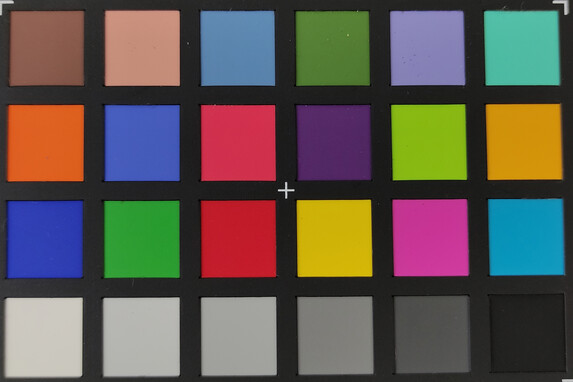

Accessories and Warranty
The warranty covers only 12 months.
In addition to the smartphone, the box includes a modular 33-watt charger (USB-A), a USB cable (Type-A to Type-C), a SIM tool, a protective clear silicone case, as well as the usual leaflets with the warranty conditions, safety instruction and quick-start manual.
Input Devices and Operation - Xiaomi smartphone with fingerprint sensor in the power button
The capacitive touchscreen of the Poco X3 offers a touch sensor rate of 240 Hz, transferring and implementing touch inputs particularly fast and accurately. The refresh rate of 120 Hz is also very high, ensuring smooth display of the contents.
For biometric security, you can use the fingerprint sensor that is integrated into the power button. It worked quite fast in our test, reliably recognizing the stored fingerprint. Optionally, you can also use 2D face recognition, but that is less secure.
There is also an option to turn on the display by lifting up the smartphone or tapping twice on the front of the glass. You have to activate the single-hand mode, which offers various display options, in the settings first.
In addition, you can create a second profile in MIUI, and compatible apps can be displayed as floating windows. The vibration motor works very accurately and convincingly, giving some easily noticeable, short jolts.
Display - IPS panel with PWM in the Poco smartphone
The 6.67-in (16.94 cm) IPS panel of the Poco X3 offers a resolution of 2400 x 1080 pixels and high pixel density of 395 ppi. With an activated brightness sensor and pure white display content, the brightness is even and high, reaching up to 623 cd/m² in the center of the display. With an even distribution of light and dark areas (APL50), the measured value slightly increases even higher (636 cd/m²). However, those who prefer to adjust the brightness manually have to be content with 481 cd/m².
At 0.54 cd/m², the black value is at a decent level, resulting in a good contrast ratio. In the APL50 measurement, the Xiaomi smartphone delivers a similar value (0.55 cd/m²). Not only does the Poco support the reproduction of DRM protected contents, but HDR10 is also nominally supported. However, the contrast and brightness are slightly too low to achieve a representable HDR effect.
The measurements with the oscilloscope also determined that Pulse Width Modulation is used for brightness control. Even though the frequency is fairly high, it could still lead to some trouble for sensitive people.
| |||||||||||||||||||||||||
Brightness Distribution: 93 %
Center on Battery: 623 cd/m²
Contrast: 1154:1 (Black: 0.54 cd/m²)
ΔE ColorChecker Calman: 1.8 | ∀{0.5-29.43 Ø4.78}
ΔE Greyscale Calman: 3.3 | ∀{0.09-98 Ø5}
99.7% sRGB (Calman 2D)
Gamma: 2.26
CCT: 6712 K
| Xiaomi Poco X3 NFC IPS, 2400x1080, 6.7" | Xiaomi Redmi Note 9S IPS, 2400x1080, 6.7" | Xiaomi Mi Note 10 Lite AMOLED, 2340x1080, 6.5" | Google Pixel 4a OLED, 2340x1080, 5.8" | Apple iPhone SE 2020 IPS, 1334x750, 4.7" | Samsung Galaxy M51 Super AMOLED, 2400x1080, 6.7" | |
|---|---|---|---|---|---|---|
| Screen | -27% | 29% | 34% | 41% | -23% | |
| Brightness middle (cd/m²) | 623 | 622 0% | 605 -3% | 705 13% | 688 10% | 626 0% |
| Brightness (cd/m²) | 600 | 612 2% | 608 1% | 707 18% | 659 10% | 632 5% |
| Brightness Distribution (%) | 93 | 94 1% | 95 2% | 96 3% | 92 -1% | 94 1% |
| Black Level * (cd/m²) | 0.54 | 0.56 -4% | 0.28 48% | |||
| Contrast (:1) | 1154 | 1111 -4% | 2457 113% | |||
| Colorchecker dE 2000 * | 1.8 | 3.98 -121% | 0.84 53% | 0.9 50% | 1 44% | 2.88 -60% |
| Colorchecker dE 2000 max. * | 4.7 | 7.33 -56% | 1.8 62% | 1.9 60% | 2.2 53% | 4.97 -6% |
| Greyscale dE 2000 * | 3.3 | 4.5 -36% | 1.3 61% | 1.3 61% | 1.7 48% | 5.9 -79% |
| Gamma | 2.26 97% | 2.206 100% | 2.211 100% | 2.26 97% | 2.25 98% | 3.441 64% |
| CCT | 6712 97% | 7361 88% | 6310 103% | 6576 99% | 6790 96% | 6415 101% |
| Color Space (Percent of sRGB) (%) | 114.9 |
* ... smaller is better
Screen Flickering / PWM (Pulse-Width Modulation)
| Screen flickering / PWM detected | 2358 Hz | ≤ 40 % brightness setting | |
The display backlight flickers at 2358 Hz (worst case, e.g., utilizing PWM) Flickering detected at a brightness setting of 40 % and below. There should be no flickering or PWM above this brightness setting. The frequency of 2358 Hz is quite high, so most users sensitive to PWM should not notice any flickering. In comparison: 53 % of all tested devices do not use PWM to dim the display. If PWM was detected, an average of 8111 (minimum: 5 - maximum: 343500) Hz was measured. | |||
The color analysis with CalMAN shows a very natural color reproduction for this price class. The default setting is automatic adjustment to the surroundings, which is fairly balanced and even slightly warmer than the "Standard" profile. The "Saturated" profile uses a slightly enlarged sRGB color space and stronger colors with a cooler display setting.
Display Response Times
| ↔ Response Time Black to White | ||
|---|---|---|
| 26.4 ms ... rise ↗ and fall ↘ combined | ↗ 11.6 ms rise | |
| ↘ 14.8 ms fall | ||
| The screen shows relatively slow response rates in our tests and may be too slow for gamers. In comparison, all tested devices range from 0.1 (minimum) to 240 (maximum) ms. » 65 % of all devices are better. This means that the measured response time is worse than the average of all tested devices (20.2 ms). | ||
| ↔ Response Time 50% Grey to 80% Grey | ||
| 44.4 ms ... rise ↗ and fall ↘ combined | ↗ 21.6 ms rise | |
| ↘ 22.8 ms fall | ||
| The screen shows slow response rates in our tests and will be unsatisfactory for gamers. In comparison, all tested devices range from 0.165 (minimum) to 636 (maximum) ms. » 75 % of all devices are better. This means that the measured response time is worse than the average of all tested devices (31.6 ms). | ||
Performance - Poco X3 with Snapdragon 732G
The Poco X3 is the first smartphone that uses the Snapdragon 732G. However, compared to the 730G, the changes turn out rather marginal, and there is mainly the additional 100 MHz for the two performance cores. However, the Adreno 618 was also upgraded and now runs at up to 950 MHz, instead of 825 MHz in the 730G or 600 MHz in the SD730.
Particularly the additional performance of the GPU becomes noticeable in the benchmarks and can make the difference between a smoothly running game and occasional stutters in graphically intensive games.
| VRMark - Amber Room (sort by value) | |
| Xiaomi Poco X3 NFC | |
| Xiaomi Redmi Note 9S | |
| Average Qualcomm Snapdragon 732G (2373 - 2538, n=2) | |
| AImark - Score v2.x (sort by value) | |
| Xiaomi Poco X3 NFC | |
| Apple iPhone SE 2020 | |
| Average Qualcomm Snapdragon 732G (4958 - 35458, n=3) | |
Due to the fast SoC and 120-Hz display, surfing on the web works smoothly, and the Poco X3 also leaves a positive impression in the benchmarks. In our comparison field, only the iPhone plays in a different league.
| Jetstream 2 - 2.0 Total Score | |
| Average of class Smartphone (23.8 - 387, n=153, last 2 years) | |
| Apple iPhone SE 2020 (Safari Mobile 13.1) | |
| Xiaomi Poco X3 NFC (Chrome 85) | |
| Average Qualcomm Snapdragon 732G (49.5 - 53.4, n=3) | |
| Samsung Galaxy M51 (Chrome 85) | |
| Xiaomi Redmi Note 9S (Chrome 81) | |
| Google Pixel 4a (Chrome 85) | |
| Xiaomi Mi Note 10 Lite (Chrome 83.0.4103.106) | |
| JetStream 1.1 - Total Score | |
| Apple iPhone SE 2020 (Safari Mobile 13.1) | |
| Average Qualcomm Snapdragon 732G (89.8 - 92.4, n=3) | |
| Xiaomi Poco X3 NFC (Chrome 85) | |
| Xiaomi Redmi Note 9S (Chrome 81) | |
| Google Pixel 4a (Chrome 85) | |
| Xiaomi Mi Note 10 Lite (Chrome 83.0.4103.106) | |
| Samsung Galaxy M51 (Chrome 85) | |
| Speedometer 2.0 - Result 2.0 | |
| Average of class Smartphone (15.2 - 643, n=126, last 2 years) | |
| Apple iPhone SE 2020 (Safari Mobile 13.1) | |
| Google Pixel 4a (Chrome 85) | |
| Xiaomi Redmi Note 9S (Chome 81) | |
| Xiaomi Poco X3 NFC (Chrome 85) | |
| Average Qualcomm Snapdragon 732G (41.4 - 43.9, n=3) | |
| Samsung Galaxy M51 (Chome 85) | |
| Xiaomi Mi Note 10 Lite (Chrome 83.0.4103.106) | |
| WebXPRT 3 - Overall | |
| Average of class Smartphone (38 - 380, n=34, last 2 years) | |
| Apple iPhone SE 2020 (Safari Mobile 13.1) | |
| Xiaomi Poco X3 NFC (Chrome 85) | |
| Average Qualcomm Snapdragon 732G (71 - 73, n=3) | |
| Google Pixel 4a (Chrome 85) | |
| Xiaomi Mi Note 10 Lite (Chrome 83.0.4103.106) | |
| Xiaomi Redmi Note 9S (Chrome 81) | |
| Samsung Galaxy M51 (Chrome 85) | |
| Octane V2 - Total Score | |
| Average of class Smartphone (2228 - 121337, n=201, last 2 years) | |
| Apple iPhone SE 2020 (Safari Mobile 13.1) | |
| Google Pixel 4a (Chrome 85) | |
| Average Qualcomm Snapdragon 732G (17293 - 17817, n=3) | |
| Xiaomi Poco X3 NFC (Chrome 85) | |
| Xiaomi Redmi Note 9S (Chrome 81) | |
| Samsung Galaxy M51 (Chrome 85) | |
| Xiaomi Mi Note 10 Lite (Chrome 83.0.4103.106) | |
| Mozilla Kraken 1.1 - Total | |
| Google Pixel 4a (Chrome 85) | |
| Xiaomi Mi Note 10 Lite (Chrome 83.0.4103.106) | |
| Xiaomi Redmi Note 9S (Chrome 81) | |
| Samsung Galaxy M51 (Chrome 85) | |
| Average Qualcomm Snapdragon 732G (2673 - 2832, n=2) | |
| Xiaomi Poco X3 NFC (Chrome 85) | |
| Average of class Smartphone (257 - 28190, n=156, last 2 years) | |
| Apple iPhone SE 2020 (Safari Mobile 13.1) | |
* ... smaller is better
In our 64-GB version of the Poco X3, there are still 43.54 GB available for the user after the first start. While Xiaomi labels the built-in storage as UFS 2.1, the access speeds in our test point to the storage as a rather slow representative of the UFS-2.0 standard.
The measurements using our Toshiba Exceria Pro M401 reference card attest the microSD reader of the Poco X3 with decent transfer values, although it does not make full use of the capabilities of the storage card.
| Xiaomi Poco X3 NFC | Xiaomi Redmi Note 9S | Xiaomi Mi Note 10 Lite | Google Pixel 4a | Samsung Galaxy M51 | Average 64 GB UFS 2.0 Flash | Average of class Smartphone | |
|---|---|---|---|---|---|---|---|
| AndroBench 3-5 | 7% | 11% | 35% | 3% | -6% | 411% | |
| Sequential Read 256KB (MB/s) | 506 | 496.6 -2% | 501 -1% | 502 -1% | 491.7 -3% | 513 ? 1% | 2226 ? 340% |
| Sequential Write 256KB (MB/s) | 173.1 | 214.8 24% | 213.2 23% | 246.8 43% | 189.8 10% | 175.2 ? 1% | 1848 ? 968% |
| Random Read 4KB (MB/s) | 123.4 | 137 11% | 134.6 9% | 162.9 32% | 123.6 0% | 117.1 ? -5% | 295 ? 139% |
| Random Write 4KB (MB/s) | 112.6 | 123.6 10% | 125.8 12% | 187.4 66% | 114.5 2% | 81.1 ? -28% | 335 ? 198% |
| Sequential Read 256KB SDCard (MB/s) | 75.2 ? | 74.5 ? -1% | 74.8 ? -1% | 73.4 ? -2% | |||
| Sequential Write 256KB SDCard (MB/s) | 55.6 ? | 54.9 ? -1% | 59.4 ? 7% | 55.4 ? 0% |
Games - HFR gaming with the Poco X3
Using GameBench, we analyze the gaming performance of the Xiaomi Poco X3 NFC. With the Snapdragon 732G, the smartphone possesses a powerful SoC that, although not offering as much power as the current high-end SoCs, still offers a sufficient amount to display all games smoothly.
However, the maximum display quality is not always possible. For example, you cannot pick the current Ultra-HD setting in "PUBG Mobile" and even in the HD mode, 30 fps are the limit, but at least those were achieved consistently.
The 120-Hz display should also allow for smoother display beyond 60 fps, and we are testing this with Armajet, which supports a maximum of 144 Hz. The performance limits of the Poco X3 are also reached here, since it only achieves a maximum of up to 102 fps. Gaming heavy-weights such as the ROG Phone 3 will reach the full 144 Hz, but they also cost a multiple of the Poco X3.
Otherwise, the Poco X3 does a very good job and offers a very reliable touchscreen, cleanly working sensors, as well as two speakers.
Emissions - Effective cooling
Temperature
As expected, the surface temperatures of the Poco X3 remain low during idle operation, but they already climb above the 30-degree mark (86 °F) in some areas. Under load, the values partially increase up to 39 °C (102 °F), which is relatively high, but still absolutely no reason for concern.
In the stress test with the GFXBench battery test, the performance of the SoC remains very stable. While it remains at a constant frame rate in the older T-Rex (OpenGL ES 2.0) as well as the Manhattan scenario (OpenGL ES 3.1), it is also limited at 60 fps.
(+) The maximum temperature on the upper side is 39 °C / 102 F, compared to the average of 35.2 °C / 95 F, ranging from 21.9 to 247 °C for the class Smartphone.
(+) The bottom heats up to a maximum of 37.3 °C / 99 F, compared to the average of 34 °C / 93 F
(+) In idle usage, the average temperature for the upper side is 29.2 °C / 85 F, compared to the device average of 32.9 °C / 91 F.
Speaker
The Poco X3 has two speakers, one of which is at the bottom and the second in the area of the earpiece with an additional output opening at the top edge. While they play fairly loud, the sound quality is only average and marked by little bass. However, this is more than adequate considering the price class.
The 3.5-mm audio port of the Poco X3 leaves a very good impression. The sound output is very linear and at 91.16 dBFS, the signal-to-noise ratio is also at a good level. In addition, there are more adjustments for wired sound output in the settings, and there are some special modes for Xiaomi's own models.
Those who want to use Bluetooth for wireless sound output can choose among the SBC, AAC, aptX, aptX HD, aptX Adaptive, LDAC, and LHDC audio codecs.
Xiaomi Poco X3 NFC audio analysis
(+) | speakers can play relatively loud (89.2 dB)
Bass 100 - 315 Hz
(-) | nearly no bass - on average 24.3% lower than median
(±) | linearity of bass is average (9.8% delta to prev. frequency)
Mids 400 - 2000 Hz
(+) | balanced mids - only 4.9% away from median
(+) | mids are linear (3.9% delta to prev. frequency)
Highs 2 - 16 kHz
(±) | higher highs - on average 5.4% higher than median
(+) | highs are linear (3.7% delta to prev. frequency)
Overall 100 - 16.000 Hz
(±) | linearity of overall sound is average (17.9% difference to median)
Compared to same class
» 15% of all tested devices in this class were better, 8% similar, 76% worse
» The best had a delta of 11%, average was 35%, worst was 134%
Compared to all devices tested
» 36% of all tested devices were better, 8% similar, 56% worse
» The best had a delta of 4%, average was 24%, worst was 134%
Xiaomi Redmi Note 9S audio analysis
(±) | speaker loudness is average but good (81 dB)
Bass 100 - 315 Hz
(-) | nearly no bass - on average 64.7% lower than median
(+) | bass is linear (0% delta to prev. frequency)
Mids 400 - 2000 Hz
(-) | nearly no mids - on average 64.7% lower than median
(+) | mids are linear (0% delta to prev. frequency)
Highs 2 - 16 kHz
(-) | nearly no highs - on average 64.7% lower than median
(+) | highs are linear (0% delta to prev. frequency)
Overall 100 - 16.000 Hz
(-) | overall sound is not linear (119.7% difference to median)
Compared to same class
» 88% of all tested devices in this class were better, 8% similar, 3% worse
» The best had a delta of 11%, average was 35%, worst was 134%
Compared to all devices tested
» 96% of all tested devices were better, 3% similar, 1% worse
» The best had a delta of 4%, average was 24%, worst was 134%
Battery Life - 5160 mAh ensure a long battery life
Power Consumption
The power consumption of the Poco X3 turns out rather moderate, which can mainly be traced back to the 120-Hz display.
Although the Xiaomi smartphone does not support wireless charging, there is fast charging with up to 33 watts. The manufacturer was so kind to include the corresponding charger in the box. Using this, the battery is completely recharged after 66 minutes, despite its size.
| Off / Standby | |
| Idle | |
| Load |
|
Key:
min: | |
| Xiaomi Poco X3 NFC 5160 mAh | Xiaomi Redmi Note 9S 5020 mAh | Xiaomi Mi Note 10 Lite 5260 mAh | Google Pixel 4a 3140 mAh | Apple iPhone SE 2020 1822 mAh | Samsung Galaxy M51 7000 mAh | Average Qualcomm Snapdragon 732G | Average of class Smartphone | |
|---|---|---|---|---|---|---|---|---|
| Power Consumption | -9% | 29% | 48% | 45% | 21% | 11% | -0% | |
| Idle Minimum * (Watt) | 0.93 | 1.5 -61% | 0.8 14% | 0.49 47% | 0.44 53% | 0.8 14% | 0.93 ? -0% | 0.848 ? 9% |
| Idle Average * (Watt) | 2.47 | 2.1 15% | 1.1 55% | 0.96 61% | 1.56 37% | 1.3 47% | 2.09 ? 15% | 1.434 ? 42% |
| Idle Maximum * (Watt) | 2.51 | 2.5 -0% | 1.8 28% | 1 60% | 1.63 35% | 1.8 28% | 2.13 ? 15% | 1.618 ? 36% |
| Load Average * (Watt) | 5.62 | 5.2 7% | 3.7 34% | 3.11 45% | 2.32 59% | 4.8 15% | 4.6 ? 18% | 7.01 ? -25% |
| Load Maximum * (Watt) | 6.93 | 7.5 -8% | 6.1 12% | 5.23 25% | 4.12 41% | 7 -1% | 6.5 ? 6% | 11.3 ? -63% |
* ... smaller is better
Battery Life
The 5150 mAh battery of the Poco X3 ensures a very good battery life, which we tested with the 120-Hz mode activated. So those who want to save a little more power can achieve an even longer battery life by deactivating that.
The Poco smartphone places very well in our comparison field, achieving a significantly longer battery life in parts, which can always be traced back to its battery size.
| Xiaomi Poco X3 NFC 5160 mAh | Xiaomi Redmi Note 9S 5020 mAh | Xiaomi Mi Note 10 Lite 5260 mAh | Google Pixel 4a 3140 mAh | Apple iPhone SE 2020 1822 mAh | Samsung Galaxy M51 7000 mAh | |
|---|---|---|---|---|---|---|
| Battery runtime | 2% | 6% | -20% | -37% | 29% | |
| Reader / Idle (h) | 40.5 | 37.7 -7% | 37.5 -7% | 37.8 -7% | 32.3 -20% | 44 9% |
| H.264 (h) | 19.8 | 21.2 7% | 22.8 15% | 17.4 -12% | 11.4 -42% | 28.1 42% |
| WiFi v1.3 (h) | 18.6 | 19.8 6% | 18.3 -2% | 11.2 -40% | 11.6 -38% | 25.1 35% |
| Load (h) | 4.7 | 4.7 0% | 5.6 19% | 3.8 -19% | 2.4 -49% | 6.1 30% |
Pros
Cons
Verdict - A strong price-performance ratio
The Poco X3 NFC offers excellent equipment, particularly when considering the low price, since the smartphone is usually available starting from 230 Euros (~$272) and on sale even sometimes below 200 Euros (~$236).
Despite its low price, the Xiaomi smartphone presents itself very complete and even offers modern equipment characteristics such as a 120-Hz display and brand new SoC. The camera equipment is also exemplary in this price class but does receive its share of complaints in this test. While the quad-camera system offers good specs on paper, the two additional 2-MP lenses don't offer any particular additional value.
The Poco X3 NFC offers very complete equipment at an affordable price.
The restrictions in the developer mode and the ads in the system are surely annoying and probably not without any problems for those concerned with data privacy. But most users won't have any interest in the developer mode. And it does not change anything about the fact that there is currently probably no better equipped smartphone in this price class than the Poco X3.
So why should you still choose a more expensive Pixel 4a or iPhone SE? Both offer a better camera quality, even if the functions are more limited. And the long update support with the Google and Apple phone will also make those the more enduring solutions, since only the update to Android 11 is relatively likely for the Poco at this point. However, in terms of the amount of functionalities, the Poco X3 is the clear winner.
Xiaomi Poco X3 NFC
- 10/13/2020 v7 (old)
Daniel Schmidt




